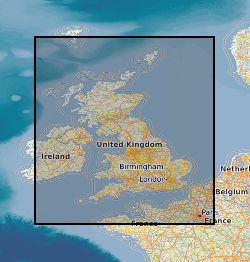Bedrock summary lithologies across the UK Continental Shelf (2014 Version)
The Bedrock summary lithologies dataset is digital geological map across the bulk of the UK Continental Shelf (UKCS), for areas up to a water depth of 200m, which groups the bedrock lithologies (rock types) into classes based on similar engineering geology characteristics. The map is derived from the 1:250,000 scale digital bedrock map of the UKCS, called DiGRock250k, which is available separately from the BGS. The map was produced in 2014 in collaboration with, and co-funded by, The Crown Estate as part of a wider commissioned project to assess seabed geological constraints on engineering infrastructure across the UKCS. The divisions on the map combine the bedrock formations into 8 classes (with several subdivisions) of similar strength and lithological variability, each with a ‘Category’ title that summarises their main lithological character: Class1 – Igneous; Class 2 - Tertiary Sandstone and Limestone; Class 2.5 - Tertiary Sandstone and Limestone Interbedded; Class 3 - Tertiary Mudstone; Class 4 - Mesozoic Sandstone and Limestone; Class 4.5 - Mesozoic Sandstone and Limestone Interbedded; Class 5 - Mesozoic Mudstone; Class 6 – Chalk; Class 7 – Metamorphic; Class 8 - Palaeozoic Sedimentary. The data are held by the BGS as an ESRI ArcGIS Shapefile.

dataset
:
http://data.bgs.ac.uk/id/dataHolding/13606629
English
Geoscientific information
GEMET - INSPIRE themes, version 1.0:
BGS Thesaurus of Geosciences:
Lithology
Bed rock
Continental shelf
UK Location (INSPIRE)
Free:
Free:
NERC_DDC
-9.6000,
48.1800,
3.4000,
61.8200
UK CONTINENTAL SHELF [id=121701]
creation: 2014-03-31
1966
-
2013
vector
British Geological Survey
Enquiries
The Lyell Centre, Research Avenue South,
EDINBURGH,
EH14 4AP,
United Kingdom
tel: 0115 936 3142
email:
enquiries@bgs.ac.uk
Role: distributor
British Geological Survey
Enquiries
The Lyell Centre, Research Avenue South,
EDINBURGH,
EH14 4AP,
United Kingdom
tel: 0115 936 3142
email:
enquiries@bgs.ac.uk
Role: point of contact
British Geological Survey
Enquiries
email:
not available
Role: distributor
British Geological Survey
Enquiries
email:
not available
Role: originator
Data Quality
The Bedrock Summary Lithology Factor Map has been derived from DiGRock250k by grouping bedrock lithologies into the following categories: Class1 - Igneous, Class 2 - Tertiary Sandstone and Limestone, Class 2.5 - Tertiary Sandstone and Limestone Interbedded, Class 3 - Tertiary Mudstone, Class 4 - Mesozoic Sandstone and Limestone, Class 4.5 - Mesozoic Sandstone and Limestone Interbedded, Class 5 - Mesozoic Mudstone, Class 6 - Chalk, Class 7 - Metamorphic, Class 8 - Palaeozoic Sedimentary. Class 1 was chosen to cover any igneous rock (granite, lava). These are frequently very strong and anisotropic in their physical properties. This class excludes tuffs as these are considered sedimentary rocks. There are no time constraints on this class as granites of Tertiary age have comparable properties to those emplaced during the Palaeozoic. Some igneous rocks such as lavas may have weathered horizons often reflecting environmental conditions when the rocks were created. Class 2 covers sands and sandstones and only a few limestones (e.g. Bembridge Limestone). Class 6 comprises chalks. This bioclastic product was separated out from other sedimentary rocks due to its easy recognition, its extensive occurrence offshore and the difficulties it has posed to pile driving for monopile wind turbines. The class occurs within both the Mesozoic and Tertiary time zones No attempt has been made to subdivide the chalk areas based on their likelihood to have flints. Experience suggests that flints can impose a constraint on foundation installation and these vary depending on basin and age. Some sediments in DigRock are described as Permo-Trias sandstones and mudstone and therefore would straddle Classes 4.5 and 8. As the classification scheme is intended as rapid attempt to summarise the strength of the rocks it was decided that such sediments are closer to the Mesozoic than most of the Palaeozoic and classes 4, 4.5 and 5 should be considered for rocks that are described as Permo-Trias. In the light of that, DigRock class PUND-MDGYAN was also moved into Class 4. It was noted that there was inconsistency in the descriptions of offshore extensions of the country rock north and south of the Cornubian peninsular. To the south the sediments are described as slates whereas to the north they are described as Sandstones and mudstones. Hence they fall into differing categories, the former as class 7 metamorphic and the latter as class 8 Palaeozoic sedimentary.
Equivalent Scale:
1:
250000
INSPIRE Implementing rules laying down technical arrangements for the interoperability and harmonisation of Geology
Commission Regulation (EU) No 1089/2010 of 23 November 2010 implementing Directive 2007/2/EC of the European Parliament and of the Council as regards interoperability of spatial data sets and services
Constraints
The copyright of materials derived from the British Geological Survey's work is vested in the Natural Environment Research Council [NERC]. No part of this work may be reproduced or transmitted in any form or by any means, or stored in a retrieval system of any nature, without the prior permission of the copyright holder, via the BGS Intellectual Property Rights Manager. Use by customers of information provided by the BGS, is at the customer's own risk. In view of the disparate sources of information at BGS's disposal, including such material donated to BGS, that BGS accepts in good faith as being accurate, the Natural Environment Research Council (NERC) gives no warranty, expressed or implied, as to the quality or accuracy of the information supplied, or to the information's suitability for any use. NERC/BGS accepts no liability whatever in respect of loss, damage, injury or other occurence however caused.
Available under the Open Government Licence subject to the following acknowledgement accompanying the reproduced NERC materials "Contains NERC materials ©NERC [year]"
licenceOGL
Metadata about metadata
166c7ca4-0bfd-1f2d-e054-002128a47908
British Geological Survey
The Lyell Centre, Research Avenue South,
EDINBURGH,
EH14 4AP,
United Kingdom
tel: +44 131 667 1000
email:
enquiries@bgs.ac.uk
Role: point of contact
2024-04-24
